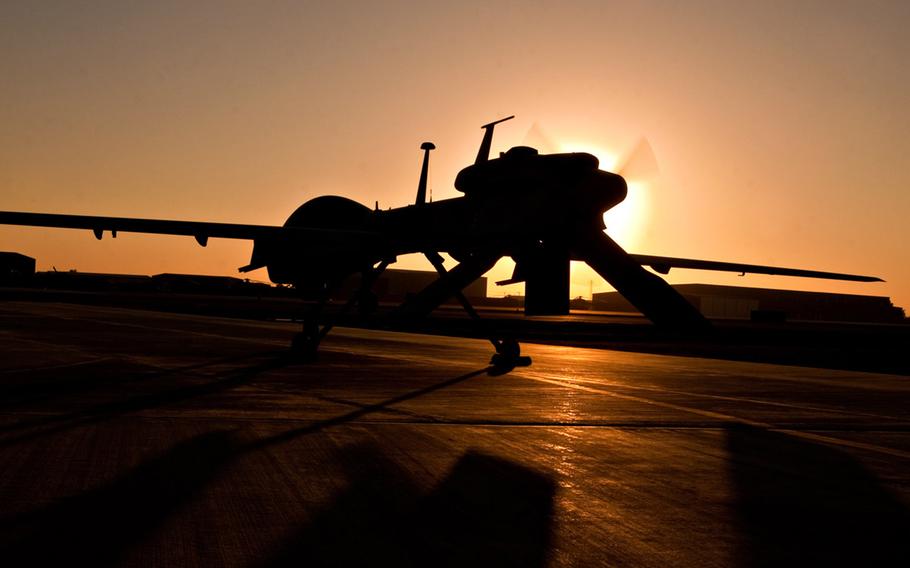U.S.
Army and Air Force drone usage takes off at Fort Drum
Stars and Stripes September 7, 2014

MQ-1C Gray Eagle, like the one that recently arrived at Fort Drum, N.Y., is silhouetted against the sun at Camp Taji, Iraq, in 2010. (U.S. Army)
FORT DRUM, N.Y. (MCT) — When U.S. troops are on the ground in unfamiliar territory, it’s vital to have eyes from the skies tracking enemy movement.
“Our focus is to support our ground troops and keep them safe overseas. That’s what we’re here for; that’s what we train for,” said Maj. Sandra D. Stoquert, spokeswoman for the 174th Attack Wing, Syracuse, which flies MQ-9 Reaper aircraft at Fort Drum’s Wheeler-Sack Army Airfield.
Joining the Reapers at the airfield, an MQ-1C Grey Eagle — a smaller, 3,600-pound unmanned aircraft that can carry as many as four Hellfire missiles — recently reported for duty at a unit activation ceremony for the “Valkyries.”
The aircraft is one of nine Grey Eagles that will join the Delta Company of the 1st Battalion, 10th Aviation Regiment, aka Valkyries.
Commonly referred to as drones, remotely piloted aircraft (RPA) are operated by a team of two — a pilot and a censor operator.
“It (unmanned aircraft) fits in everywhere. It really provides the needed situational awareness for proper decision-making on the battlefield,” Chief Warrant Officer 3 Ryan J. Owen, the company’s executive officer, said at this past July’s activation ceremony.
Takeoffs and landings are handled by a ground-control station, but once the drone reaches flying altitude, control can be handed over to pilots and censor operators in the United States through satellite links.
When training, the 174th Attack Wing’s 10,500-pound Reapers are flown out of Fort Drum’s airfield by airmen at the base, who transfer control to remote cockpits in Syracuse.
“It’s just like a typical cockpit. They (pilots) are in control of the speed, everything. It’ll have a throttle, everything that a typical pilot would have in an aircraft,” Maj. Stoquert said.
And like any other aircraft, accidents can occur while operating drones.
Most recently, a $10 million Reaper crashed Nov. 12 into Lake Ontario — about 12 miles off the coast of the lake’s eastern shore — due to navigational software failures.
The U.S. Air Force has since remedied the software problem.
Some people also are concerned that military RPAs could be used to spy on U.S. citizens, but Maj. Stoquert said federal law prohibits such use of drones.
“We cannot break U.S. laws and conduct surveillance on U.S. citizens. We know people worry about that, but there are laws in place to prevent that from happening,” she said.
Although the Army will be drawing down its active-duty forces from about 520,000 soldiers to fewer than 450,000 in 2020, it plans to launch a Gray Eagle company for each of its 10 active-duty divisions across the country, and for a few special operations units.
Pending approval by Congress is a proposed $27 million project to build a new hangar for the Gray Eagles at Fort Drum. Construction for the project could begin as soon as next spring, and would take two years to complete.
©2014 Watertown Daily Times (Watertown, N.Y.) Visit Watertown Daily Times (Watertown, N.Y.) at www.watertowndailytimes.com Distributed by MCT Information Services